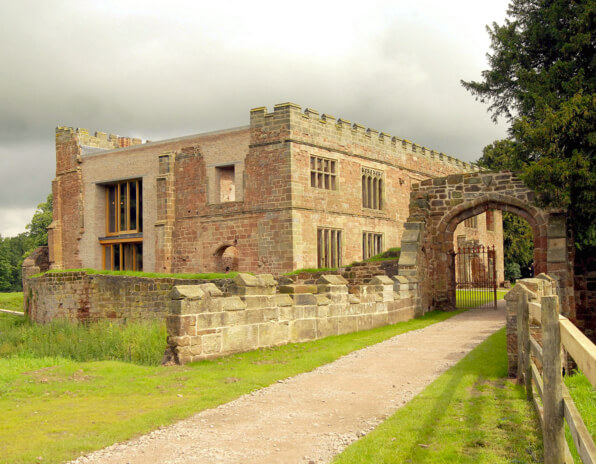Deemed too costly and complex to renovate, the fire damaged and derelict Astley Castle.
That was before its triumphant rebirth in 2012. Formerly owned by three English queens, Astley Castle gained a new crown in 2013 by winning the RIBA Stirling prize. A JCT Intermediate Building Contract with contractor’s design was the contract solution at the centre of this ancient showcase.
Located in North Warwickshire, Astley Castle started its life in the 12th Century as a fortified manor house. In 1420, Sir William Astley died, leaving the estate to his daughter, who married Reginald Grey, 3rd Baron Grey de Ruthyn. It is the Grey family ownership of the castle in the 15th and 16th Centuries, which was responsible for the most important historical elements – both in terms of the surviving architecture today and the castle’s role in national events during this time.
Elizabeth Woodville, after the death of her husband Sir John Grey, would eventually become Edward IV’s Queen in 1464. Her daughter, Elizabeth of York, became Queen in 1486 following her marriage to Henry VII. Frances Brandon, granddaughter of Elizabeth of York, married Henry Grey, Duke of Suffolk and their daughter, Lady Jane Grey was proclaimed Queen in 1553, reigning for just 9 days. She, her husband and her father were executed in 1554.
With the family in disgrace, the castle fell into decline. In 1600, it was bought by Sir Edward WarwickshireChamberlain who continued to carry out many alterations to the fabric. During the English Civil War, Astley Castle functioned as a Parliamentary stronghold.
In the 19th Century, Astley Castle was turned into a country house and was granted Grade II* listed status in 1951. Whilst operating as a hotel in 1978 it was badly damaged by a fire, with only a rectangular range of ruined two-storey buildings with an embattled parapet remaining. The below ground site and curtain walls have been a registered scheduled ancient monument since 1994.
It was during this time that Astley Castle came to the attention of the Landmark Trust, who took a 99 year lease from the Arbury Estate, who owns the castle. Unable to find a workable solution at the time due to the extent of the fire damage, Landmark returned to the project in the year of their 40th anniversary by running an architectural competition to establish a 21st Century landmark designed to provide new living accommodation within the fabric of the ancient structure:
“We aimed for the best modern architecture, unashamedly but sympathetically stitched into ancient fabric, today’s craftsmen and women linking hands with their predecessors.”
With management by Landmark Trust and funding from Heritage Lottery, the building has undergone a significant change to celebrate the historic remains with an innovative scheme to provide contemporary holiday accommodation within the shell of the remaining castle.
British architects, Witherford Watson Mann, won the bid for the work with their unique concept of merging the new and old to allow them to work effectively together. The new building would be used to fortify and support the ancient structure, which presents a more subtle and integrated approach than the common juxtaposition of old and contemporary.
The design approach was explained as being ‘upside-down-inside-out’, by having the new house placed within the oldest part – the 14th Century core – and by having the living space situated on the first floor, to maximise the views of the surrounding landscape. The 15th and 17th Century works surrounding the core are kept as open courtyards. One of the courtyards now functions as an outdoor dining room, which whilst roofless, still contains the original large fireplace and the original window shutters, providing an evocative and theatrical space.
Strategy and detail have been inseparable in dealing with the integration of eight centuries’ worth of differing construction methods and materials. Indeed, the most compelling element to Astley Castle is the geological approach to the architecture, where old juxtaposes with new, building materials and design being handled sensitively so that the new is set alongside the old in a way that exposes and reveals the layers of material, culture and texture. Perhaps more impressive is the way that this also works in reverse. The new, skeletal, timber-framed staircase evokes an exposure of what the original may have been like.
Construction works took around 84 weeks and were carried out by main contractor, William Anelay. Contracting work involved joinery, brickwork, stonemasonry, roofing, pointing and leadwork. The new building element incorporates low carbon, contemporary materials, including an air source heat pump and green roof technology. The ground floor contains the holiday accommodation, including four double bedrooms, three bathrooms, staircase and a passenger lift to the first floor. The second floor incorporates a large open living space with panoramic views to three sides.
With such a clear understanding between client, architect and contractor as to the concept and undertaking of a project of this nature, the JCT Intermediate Building Contract with contractor’s design provides an equally complementary solution. Inevitably, design decisions in a project of this type must be able to be made on the ground and the Contractors’ Design element of the contract provides this flexibility. The clarity of the Intermediate Contract is also a benefit to parties on a project of complexity, where strategy and detail must be carefully arranged. The Intermediate Contract is particularly useful for fostering collaboration between the parties in setting out and following their strategy.
In the case of Astley Castle, this subtle management of detail, design, sensitive construction and innovation has not only provided a much-needed restoration to an ancient building, but triumphantly reveals and represents its history in a living, dynamic way.
Images: Landmark Trust

